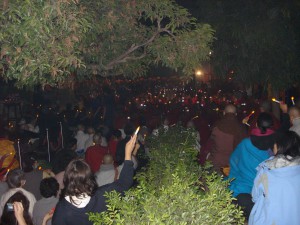I have just arrived back, and it is time to reflect on my trip to India.
Once I arrived in Bodhgaya, the seat of Buddhas enlightenment, I was so immediately swept up in the energy of the place, it was very difficult to take myself out of it enough to blog. But now, while the memories are still fresh, its time to put down a little of what I saw.
Winter in Bodhgaya is pilgrimage season, and the only time when many foreigners come throughthis is due to unbearable heat and/or monsoon conditions there about eight months out of the year.
If one pays a visit to Bodhgaya from December through February, one can expect to see people from all over the world: China, Vietnam, Tibet, Bhutan, Thailand, Sri Lanka, and, increasingly, people from the west.
I was there in part to attend the Kagyu Monlam. Monlam is a Tibetan word which means aspiration and Kagyu is one of the four major schools of Tibetan Buddhism. The event is held under the auspices of the 17th Karmapa, Orgyen Thrinley Dorje, who is the lineage holder, or leader, of the Kagyu school. At 25 and pegged by some as the successor to the Dalai Lama, he has a big job on his shoulders.
Thousands of people from various Kagyu monasteries and from across the globe descend on Bodhgaya. They book every hotel room and jump start the local craft and souvenir economy, in addition to events by the Mahabodhi Temple, the monument that marks the spot of Buddhas Complete Awakening.
All the while tour groups from other countries and traditions of Buddhism continue to arrive and depart in an unceasing flow which continues throughout the season. In doing one kora, or circumnabulation, around the Great Stupa, and the Mahabodhi Temple is also called, one can see Theravada monks chanting from the Pali cannon; old Tibetan ladies completing their thousandth prostration of the day; a Chinese tour group beings led by Mahayana monastics; people dressed in robes of dubious origin asking for money; Bhutanese, easily identified by their national dress; and Americans and Europeans practicing the full range of Buddhist styles.
All of this contributes to an unceasing sense of movement and color in Bodhgaya which never seems to stop while the temple complex is open, from five in the morning to nine at night, seven days a week, the grounds are full of pilgrims, practitioners, and trouists, while just outside the flow of merchants, local guides, and services aggressively caters to ones needs, whether real or not.
In short, it is a very energetic place. I will write about more details of it in further entries.




